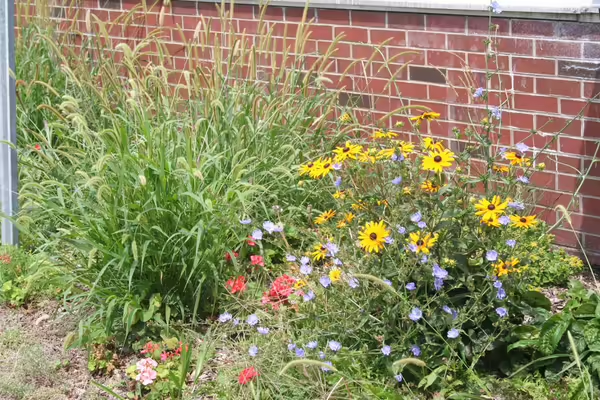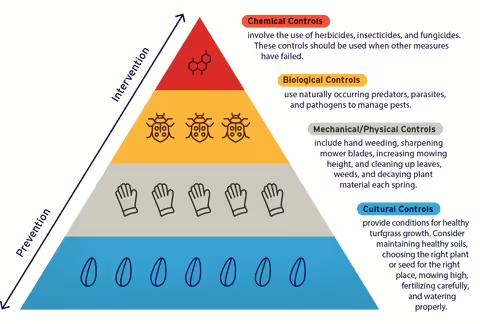
URBANA, Ill. – It finally happened - your garden’s first tomato is ready. Bright red and plump, you can practically taste it, but on closer inspection someone already has.
Do you dig out your trusty bottle of insecticide?
Not so fast, says Michelle Wiesbrook, a University of Illinois Extension expert in pesticide safety and horticultural weed science. Pesticides have their place in weed control and pest management, but using them incorrectly can harm pets and kill beneficial insects, and collectively with that of your neighbor's pesticides leach large amounts of chemicals into waterways and drinking supplies.
“We recommend that you use pesticides as a last resort,” Wiesbrook says. “A lot of times there are other controls that will work.”
Integrated Pest Management, or IPM, uses a variety of tools to reduce pest risks and help minimize economic, health, and environmental risks of chemical interventions. The approach uses four types of controls: cultural, mechanical, biological controls, and chemical.
Pest Identification
Do Your Homework
The first step in managing pests is knowing what you are dealing with. One insect or weed can be mistaken for another and products are targeted at specific pest species. Applying the wrong one may have no effect and is a waste of time and resources.
“If you have a persistent pest or persistent weed problem, certainly pesticides can be very useful tools,” Wiesbrook says. “But do your homework first. Make sure you know what you have before you go to the store and start looking for a pesticide.”
Staff at the Plant Clinic or local county Extension offices can assist with identification, provide recommendations, and also advise on local outbreaks or issues.
Preventing Pests with Cultural Controls
Cultural controls are simple steps gardeners can take to set the stage for a strong, healthy landscape that is less susceptible to disease and attack.
That’s the approach promoted by Allison Neubauer, an outreach educator with Illinois-Indiana Sea Grant. Neubauer teaches communities about natural lawn care practices so they can cut back on nutrient and chemical pollution, conserve water, and contribute to healthier ecosystems.
Choose the right plant for the right place, water plants consistently, keep gardens and lawns free of materials that might act as a breeding ground for pests, mow turf to the ideal height of 3 inches.
“We also recommend taking a soil test, especially if you’re a new gardener, so that you know what nutrients are there, and what nutrients are lacking,” Neubauer says. “Then you can get some help interpreting results, and better understand how you can make amendments and create a more productive environment.”
A soil test can help gardeners create a custom fertilizing and pest treatment plan. By adding only what’s needed, there is less chemical runoff escaping into the ecosystem.
By Hand: Manual Interventions
Mechanical controls such as maintaining gardening tools and removing pests by hand can help prevent symptoms and outbreaks. Taking a few minutes to pick bagworms out of trees, pour salt on snails, or pull weeds by hand as they pop up goes a long way.
“Have the kids help you. You can dig up a few random dandelions before you apply a product to the whole lawn,” Wiesbrook says. “Maybe that product won’t even be necessary if you can use other controls.”
Sharpening mower blades is also important. Clean-cut grass blades heal faster and are less likely to look frayed and yellow and falsely lead gardeners to wonder if the lawn needs chemical intervention.
“You might mistake that as a symptom of a nutrient deficiency or some other fungal diseases when you actually have dull mower blades,” Neubauer says.
Nature vs. Nature: Biological controls
Biological controls use nature to fight nature. Gardeners can buy ladybugs and other beneficial predator insects and release them in an area where they will eat pests. Assassin bugs live up to their name by devouring medium-sized insects such as leafhoppers and aphids. Robber flies are particularly adept at helping gardeners battle grubs and other soil pests that attack lawns.
It’s also good practice to interrupt the life cycle of the weed or pest that you are targeting. Pull weeds before they go to seed. Remove larvae before they mature. “Knowing when pests reproduce, when they’re laying eggs, that’s when you’d want to get out there and treat it before they hatch,” Neubauer says.
Chemical controls
When all else fails, pesticides can be useful tools for persistent problems, but these powerful chemical controls must be used carefully.
Farmers and landscapers are required by law to be certified on how to handle restricted-use pesticides. Home gardeners are limited only by what pesticides are available to them in garden centers.
“These are chemicals that are designed to cause harm to living things,” says Neubauer. “So, whether it’s a weed or an insect, it’s not selective in that it could still have an impact on non-targeted organisms.”
The first step to safe application is reading the product’s label which will explain what pests it is for and the conditions for safe use. The label has other helpful instructions, including where it can be applied. Some pesticide formulas cannot be used on edible plants.
“The label is the law,” Wiesbrook says. “Consumers are actually required to read and follow all label directions.”
The Environmental Protection Agency publishes a primer on reading pesticide labels and other helpful information.
Applying Pesticides
The product label will also provide directions on how and how much of the product should be used. If high winds and rain are in the forecast, wait to apply. Rain can wash newly applied chemicals down the drain and wind can blow it into other areas.
“Some products can injure desirable landscape plants,” Wiesbrook says. “If the wind is blowing toward your neighbor’s rose bushes, it’s probably a good idea to wait for that wind to subside to apply.” More is not better when it comes to pesticides.
The product’s instruction label, known as Directions for Use, will note how much to use in the square feet of a specific area. Some pesticides need to get inside the plant. If the rate is too high, the pesticide can burn the plant and the product won’t work. “It is illegal to apply more than what that label directs,” Wiesbrook says.
Personal Safety
Pesticides and fertilizers are chemicals that can hurt adults, children, pets, and livestock when inhaled or absorbed through the skin. Safety should be a priority when using them.
“Too many times, I’ve seen people spraying and their kids or pets are following behind them,” Wiesbrook says. “That’s certainly not something we want to see. But people don’t understand the dangers and the risks.”
- Storage: Safely keep chemicals and products out of reach of children, and according to the label guidelines.
- Use personal protective equipment: Coveralls or pants and long-sleeved shirts, gloves, enclosed footwear, headgear, eyewear, and respirators as required by the product label.
- Application: Remove pets and children’s toys. Do not apply when anyone is in the space. Apply with the proper equipment.
- Post-application: Shower and immediately wash clothes worn during application. Follow label directions about how long to stay off turf or garden surfaces.
Tolerate Imperfect Landscapes
Finally, increase your tolerance of the occasional weed. Gardening channels, magazines, and photos offer up images of flawless landscapes, which sets unrealistic expectations for gardeners. Weeds are natural and some like dandelions can feed butterflies, bees, and other beneficial insects.
This growing season, instead of reaching for a bottle of pesticide, pick the caterpillars off of your tomato plants and let that weed in the back corner of your yard live another day.
Pest Management Resources
- Identifying Weeds in Midwestern Turf and Landscapes: This primer helps people identify more than three dozen of Illinois’ most common lawn weeds.
- University of Illinois Plant Clinic: Submit plants and insect for identification, diagnosis of disease, field crop chemical injury and help with nutrient-related problems.
- Illinois-Indiana Sea Grant, Managing Lawns with Fewer Chemicals: Lawn to Lake specialists can help you understand more about how garden practices impact ecosystems.
- National Pesticide Information Center: Resources, fact sheets, and consultation about pests, pesticides, and pesticide use.
- USDA National Institute of Food and Agriculture Integrated Pest Management Program: Programs, resources, and information about IPM.
Illinois Extension leads public outreach for University of Illinois by translating research into action plans that allow Illinois families, businesses, and community leaders to solve problems, make informed decisions, and adapt to changes and opportunities.
